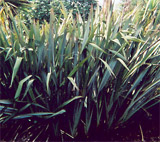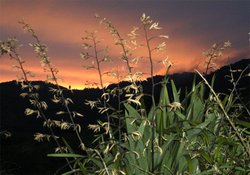New Zealand flax
|
|
| New Zealand Flax | ||||||||||||||
|---|---|---|---|---|---|---|---|---|---|---|---|---|---|---|
 New Zealand Flax | ||||||||||||||
| Scientific classification | ||||||||||||||
|
New Zealand Flax (Phormium tenax), known as Harakeke by New Zealand Maori for many centuries, was and still is one of the most versatile plants in the world.
It is found mainly in swamps or low lying areas but will grow just about anywhere and is also much propagated in gardens as an evergreen decorative plant, both in New Zealand and now worldwide. It is quite distinct from the Northern Hemisphere plant known as flax (Linum sp.).
Phormium is an herbaceous perennial monocot. Monocot classification has undergone significant revision in the past decade, and recent classification systems (including the Angiosperm Phylogeny Group) have found Phormium to be closely related to daylilies (Hemerocallis).
| Contents [hide] |
Appearance
The tough, sword-shaped leaves grow up to three metres long and up to 125 mm wide. They are usually darkish green but sometimes have coloured edges and central ribs. Cultivated varieties range from light green through pink to deep russet bronze. There are numerous variegated cultivars with leaves marked by contrasting stripes in shades of green, red, bronze, pink and yellow.
NZ_flax_flower.JPG
The rigid flower stalks can be up to five meters long, projecting high above the foliage. In November (in New Zealand) they produce clumps of curving tube-like flowers which turn bright red when mature. These produce unusually large quantities of nectar to attract all nectar feeding birds such as the tui and insects. The seedpods that develop after pollination, each contain hundreds of seeds which are later widely dispersed by the wind.
Versatility
The naturalist Jacques Labillardière collected indigenous flax plants when French ships visited the far north of the North Island of New Zealand in 1793. He had noted the many uses the Maori had put to the plant and in 1803 gave it the scientific name Phormium, meaning "basket" or "wickerwork", and tenax meaning "tenacity" or "holding fast".
Plaiting and weaving (raranga) the flax fibres into baskets were but only two of the great variety of uses made of flax by Maori who recognised nearly 60 varieties, and who carefully propagated their own flax nurseries and plantations throughout the land.
Leaves were cut near the base of the plant using a sharp mussel shell or specially shaped rocks, more often or not greenstone (jade, or pounamu). The green fleshy substance of the leaf was stripped off, again using a mussel shell, right through to the fibre which went through several processes of washing, bleaching, fixing, softening, dyeing and drying.
The fibres of various strengths were used to fashion eel traps (hinaki), surprisingly large fishing nets (kupenga) and lines, bird snares, cordage for ropes, baskets (kete), bags, mats, clothing, sandals (parara), buckets, food baskets (rourou), and cooking utensils etc.
The flax fibre called muka which was laboriously washed and bleached and hand worked until it became extremely soft is the base for the beautiful feather cloak, the kahu huruhuru, a traditional garment that is highly prized by Maori. It is adorned with colourful feathers from the native huia, kiwi, tui, kereru (woodpigeon) and kaka (parrot).
The handmade flax cording and ropes had such great tensile strength that they were used to successfully bind together sections of hollowed out logs to create huge ocean-going canoes (waka). It was also used to make rigging, sails and lengthy anchor warps, and roofs for housing.
Frayed ends of flax leaves were fashioned into torches and lights for use at night. The dried flower stalks, which are extremely light, were bound together with flax twine to make river rafts called mokihi.
Medicinal properties
For centuries, Maori had collected the abundant nectar from the flowers to make a crude honey and to generally sweeten foods, but it was the myriad of medicinal uses that made the plant so important to the everyday health of Maori.
Flax roots were boiled and crushed and applied externally as a poultice for boils, tumours and abscesses, as well as to varicose ulcers.
Juice from the pounded roots was widely used as a disinfectant, and taken internally to relieve constipation or expel worms. It was also applied to bullet or bayonet wounds.
The gum-like sap produced by flax contains enzymes that give it blood clotting and antiseptic qualities to help healing processes. Though unaware of the enzymes, Maori were fully aware of its curative properties and that it is a mild anaesthetic, and widely applied the sap to boils and various wounds, to aching teeth, to rheumatic and associated pains, to ringworm and various skin irritations, and especially to scalds and burns.
Splints were fashioned from bases and flax leaves, and thin strips of muka fibre were disinfected in the gel before being used to stitch wounds. Flax leaves were used as bandages and to secure broken bones much as plaster is used today, and the pulp of pounded leaves was applied as dressings.
Flax was and still is used in numerous cosmetics such as soaps, shampoos and hand lotions.
Flax seed oil from New Zealand flax is not commercially available, but its production and properties are currently beeing researched. Flax seed oil that can be bought in many countries (aka linseed oil) is extracted from the seeds of the European flax, a plant that belongs to a different plant family.
Defence uses
During the early Musket Wars and later New Zealand Wars, Maori used large, thickly woven flax mats to cover entrances and lookout holes in their pa fortifications.
Some warriors wore a type of vest jacket fashioned from heavily plaited sections of flax. If they weren’t deliberately designed to have the same effect as today’s flak jackets, they achieved the same purpose by decelerating a musket ball so successfully its effect dropped from being lethal to wounding only.
International trade
In the very early 1800s the quality of rope materials made from New Zealand flax was already widely known internationally, as was the quality of New Zealand trees which were used for spars and masts, and the British Navy was one of the very largest customers.
The flax trade burgeoned, especially after male Maori recognised the advantages of trade and adapted to helping in the harvesting and dressing of flax which had previously been done exclusively by females. (Stripping machines later replaced the manual labour.)
An unforeseen consequence of this growing trade, with tragic outcomes for Maori, was the trading of flax for flintlock muskets which prompted one-sided intertribal warfare and led to the well documented Musket Wars which decimated many tribes.
External link
Hakakeke/Flax - New Zealand Department of Conservation (http://www.doc.govt.nz/Conservation/001~Plants-and-Animals/002~Native-Plants/Harakeke-(Flax).asp)

